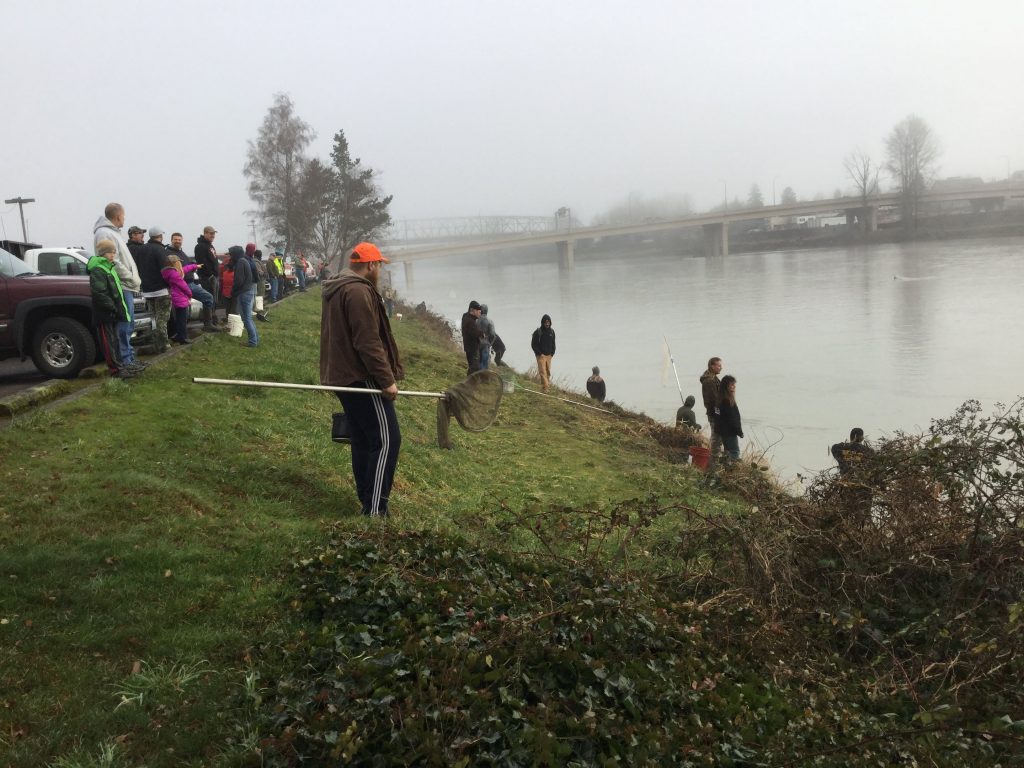
Smelt Reported In Cowlitz As Far Up As Lexington
Wednesday’s news that smelt dipping would open Saturday, March 5, on the lower Cowlitz may have drawn a few arched eyebrows from Northwesterners still drying out from the atmospheric river that hit early this week and spiked stream flows, but the little oily fish apparently don’t mind a little rain.

Smelt are reported as far up the Southwest Washington river as Lexington, just north of Kelso, where they were seen on the surface and there appeared to be a “constant run … along the bank,” according to WDFW sources.
That’s good for dippers hoping to take advantage of the 8 a.m. to 1 p.m. opener between the Highway 432 Bridge just above the mouth of the Cowlitz to the Al Helenberg Memorial Boat Ramp above the Highway 411/A Street Bridge in the town of Castle Rock.
Even as the river remains relatively turbid, flows at Castle Rock have dropped below 20,000 cubic feet per second from Tuesday’s high of 50,000 cfs.
Smelt dipper MD Johnson wasn’t concerned at all about how muddy the river was and said it might actually help.
“When it’s like it is now, they’ll be more likely to run during daylight,” he said the evening WDFW announced the opener. “Everything wants to eat them. They’re like an aquatic cottontail rabbit.”
Before the flood, the Cowlitz had been running very clear, relatively speaking, according to the USGS gauge.
WDFW smelt biologist Laura Heironimus noted that smelt are prey for many other species, so thicker water could be right up their alley.
“A higher turbidity may actually encourage them to enter a river to spawn because it helps provide cover from predators,” she noted.
“Temperature is also an important factor and our data suggests smelt in the Columbia prefer temperatures warmer than 4°C (39.2°F). I think the cold, clear conditions in January and early February may have actually slowed the run into the Columbia and may be why we’re seeing a later run this year,” Heironimus added.
The commercial fishery on the mainstem Columbia, which is actually used more to gauge the strength of the Endangered Species Act-listed run and help time sport fisheries, didn’t see any landings until mid-February, and then they spiked, with over 15,000 pounds landed so far.
During an ODFW-WDFW teleconference on Tuesday, netboater Gary Soderstrom reported a “huge volume” of smelt in the big river, and that it was taking just minutes and “a little piece of net” to catch good numbers.
He suggested the schools at the time weren’t far below the Cowlitz.
“They come up quick, they go down quick,” noted Johnson, who lives in Cathlamet and reported that he and his wife were going to try their hand Saturday morning at Gearhart Gardens, near the mouth, after breakfast at the Pancake House.
For the Johnsons, the opener might be more akin to a social event than securing smoked snacks and sturgeon bait.
“We go for the carnival atmosphere. BS with people, maybe meet Laura,” he said.
Indeed, Heironimus and fellow WDFW staffers will be hosting nine sampling stations along the Cowlitz.
“Gearhart, Allen Street, Carnival Market, Rocky Point, Lexington, Camelot, and the boat ramp by Castle Rock, plus maybe a few extra ‘rovers’ walking around and checking people,” she said.
Dippers are encouraged to stop by as the stations are a great opportunity to not only help biologists collect data on the run but learn more about the ESA-listed fish.
They were put up during 2021’s five-hour Wednesday opener and helped determine that 96 percent of the estimated sport catch of roughly 925,650 fish were male. This year’s forecast is for a larger return.
Overall last March, 9,900 dippers harvested an estimated 90,750 pounds worth of smelt, near limits.
Speaking of limits, WDFW states that these are the rules:
“Each dip-netter may retain up to 10 pounds of smelt per day, with no more than one day’s limit in possession. Ten pounds is about a quarter of a 5-gallon bucket, but anglers are encouraged to bring their own scale for tracking. No fishing license is required to dip net for smelt in this limited fishery. All smelt caught must be retained up to the daily limit. Smelt may only be taken with a handheld dip net that may not exceed 36 inches across the bag frame with a maximum 5/8-inch stretch mesh size and must have a rigid handle.
“All individual harvesters must use a separate container to hold their catch, and the container must be in the harvester’s presence or identified with the harvester’s name. It is unlawful to harvest smelt from a vessel.“
The news of an opener had a local sporting goods store and one further afield immediately announcing they had smelt dipping nets in stock, but if you get one from Bob’s in Longview, know that you can’t return ’em right after getting your limit.
While the Cowlitz is dropping, its velocity is still higher than normal, so fishermen should keep safety in mind, something that both Johnson and Heironimus worried about.
“In past years I’ve watched people walk way out into the middle of the river to try to dip smelt and I always worry about kids going out there or someone slipping and going under,” Heironimus said.
The river is forecast to continue to drop through Saturday but hopes are that it will still be on the dirty siide.
“That should give us some good dipping conditions if it all works out!” she said.
Fingers crossed!

